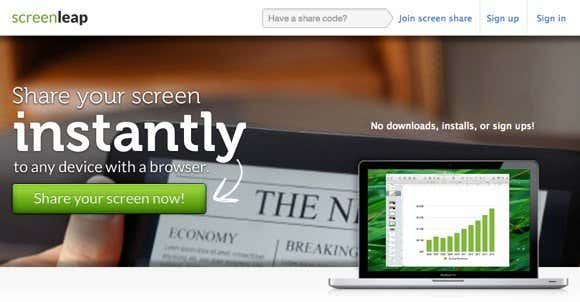
- #Online screen sharing browser full#
- #Online screen sharing browser software#
- #Online screen sharing browser windows#
getDisplayMedia (displayMediaOptions ) dumpOptionsInfo ( ) } catch (err ) Īfter clearing the contents of the log in order to get rid of any leftover text from the previous attempt to connect, startCapture() calls getDisplayMedia(), passing into it the constraints object defined by displayMediaOptions. In this case, the user agent may include the obscured content, either by getting the current contents of the hidden portion of the window or by presenting the most-recently-visible contents if the current contents are not available. This is done for security reasons, as the content that cannot be seen by the user may contain data which they do not want to share.Ī user agent might allow the capture of the entire content of an obscured window after gaining permission from the user to do so. Generally, the browser will provide an image which obscures the hidden portion of the logical display surface in some way, such as by blurring or replacing with a color or pattern.

How these are handled by the Screen Capture API varies. A visible display surface is a surface which is entirely visible on the screen, such as the frontmost window or tab, or the entire screen.Ī logical display surface is one which is in part or completely obscured, either by being overlapped by another object to some extent, or by being entirely hidden or offscreen.
#Online screen sharing browser windows#
Sharing surfaces include the contents of a browser tab, a complete window, all of the windows of an application combined into a single surface, and a monitor (or group of monitors combined together into one surface). If something's not working: ask your coworker to close their browser, then refresh this page, re-share the screen and send the link to your coworker again.For the purposes of the Screen Capture API, a display surface is any content object that can be selected by the API for sharing purposes. It should work though, but there are always some real world scenarios where it won't. It might not work in Firefox or if both you and your counterparty are behind symmatric NATs. This is an early stage experiment, a proof of concept if you will.

Also you can add some more random stuff to the URL-hash and load the page again to make it harder to guess. But once someone's joined - the app won't let anyone in. All rooms are public in this beta version. See for yourself: just look at this page's source code, it's all there ) Can someone guess my "room number"? So we wrote a small signaling server to help with that (and also manage "rooms"). The two browsers need to exchange some magic numbers before they can find each other. Yes, but only during the handshake phase. But I can spot connections to your server!

This is peer 2 peer, the video stream is not being sent to our servers, your browser streams the video directly to the viewer's browser. OTOH there's a peer-2-peer video technology that's literally built right into everyone's browser. Some of those video tools (cough cough) are not very privacy friendly.

We've built this fun little side project during the days of COVID-19 when everyone's remote and found themselves in need of video connectivity tools.
#Online screen sharing browser full#
Just a modern browser that supports WebRTC (current beta works in Chromium browsers, somewhat functional in Firefox, with full Safari/Firefox support coming up shortly).
#Online screen sharing browser software#
No plugins, no extensions, no 3rd party software like TeamViewer or something. Use it to quickly share your screen with a co-worker remotely. This is a free, very basic browser based screen sharing app between 2 people.


 0 kommentar(er)
0 kommentar(er)
